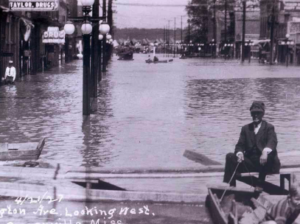News & Views
The Great Flood of 1927

The great flood of 1927 left Greenville waterlogged for months. This photo was shot looking west on Washington Avenue. Courtesy of the Nelken Archives, Greenville, Miss.
This feature previously appeared in What Ever Happened to Main Street? a publication produced by the Delta Poverty Project and the Meek School of Journalism & New Media at the University of Mississippi and is published here with permission of the Meek School.
Perhaps nothing in Greenville’s history stokes the imagination and fears of its citizens than the 1927 flood. Eighty-three years later, whenever the river creeps up the earthen levees along its banks, the people of Greenville grow nervous. And no wonder.
On April 21, the river broke through the levee at Stops Landing north of the city. With a force greater than Niagara Falls, water gushed through a crevasse three-quarters of a mile long. The next day, accompanied by mournful sirens, it reached Greenville. With 10 feet of water rushing through its streets in a steady, fearful hiss, people clung to tree limbs and rooftops for safety.
Hundreds took to the levee for safety and many African-Americans would spend weeks in tents atop the wall of dirt that had failed to hold the river. For 60 miles to the south and 90 miles to the east, the
Delta became a turbulent, churning inland sea the size of Rhode Island.
As William Alexander Percy would put it in Lanterns on the Levee, it was “deep enough to drown a man. swift enough to upset a boat, and lasting enough to cancel a crop year… The South Delta became 7500 square miles of mill-race in which 120,000 human beings and 100,000 animals squirmed and bobbed.”
In Greenville, the situation quickly became dire. Thirteen thousand African-Americans were stranded on the levee with little more than blankets and makeshift tents.
In time, Herbert Hoover would head a relief effort and help would flow to the city. But it would take four months for the water to recede. It took Greenville much longer than that to recover.


















